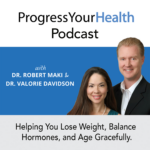
 In this episode, we answer a reader question about her low T3. Kelli’s case is a bit complicated, but it sheds light on how important it is to address low T3 levels. We get this question all the time about the thyroid hormone, T3. Many will say, ‘my free T3 levels are low, but my doctor will not do anything about it’. We wanted to talk about low T3 and how there are many factors that can cause a low T3. Also on ways to increase your T3 conversion as well as some medications for low T3. We are also going to touch on autoimmune diseases such as Hashimoto’s, Type I diabetes and Celiac disease.
In this episode, we answer a reader question about her low T3. Kelli’s case is a bit complicated, but it sheds light on how important it is to address low T3 levels. We get this question all the time about the thyroid hormone, T3. Many will say, ‘my free T3 levels are low, but my doctor will not do anything about it’. We wanted to talk about low T3 and how there are many factors that can cause a low T3. Also on ways to increase your T3 conversion as well as some medications for low T3. We are also going to touch on autoimmune diseases such as Hashimoto’s, Type I diabetes and Celiac disease.
Question from Kelli:
My thyroid labs are all within the normal range, but I FEEL so depleted. My free t3 has never tested above 2.3. I have T1D and Celiac disease already. I know my body is prone to be difficult and function lower on some levels than most. How can I fix my free t3 if it is low and if the doctor says it’s not “treatable low.”
One of our most popular blog posts is, ‘Low T3 levels”. This partly why we wanted to talk about Kelli’s concerns about her autoimmune diseases and her low T3. Kelli is one of a common predicament that we see all the time. Having low levels of FreeT3 but her doctor says it’s not treatable or just ignores it. Low T3 levels are very much treatable and should not be blown off. We really like Kelli’s questions because she also has Type One Diabetes (T1D) and Celiac disease.
T1D is considered an autoimmune disease and shouldn’t be confused with Type Two Diabetes. T1D is where the immune system will attack the insulin-producing cells in the pancreas. So the pancreas cannot release insulin in response to elevated levels of blood sugar. Type One Diabetes is considered, insulin-dependent and most likely diagnosed before the age of 20.
Kelli also has Celiac disease which is an intolerance to gluten. In the small intestines, there are little finger-like projections called microvilli which is what absorbs what we have eaten. Think of it as a long carpet/rug. You then squish up the rug together, so there are many undulations. This increases the surface area tremendously, and then there is more area to absorb nutrients. In celiac, because of the immune reaction to gluten will cause terrible damage to the microvilli. Causing the villi to erode consequently causing many symptoms including malabsorption and malnutrition.
If Kelli has T1D and Celiac and Low T3 levels she very well may have Hashimoto’s. Hashimoto’s is a condition where the immune system creates antibodies attacking the thyroid and eventually causing lowered thyroid function. Hashimoto’s can be similar to celiac. There is a sensitivity to gluten in Hashimotos that patients do much better on a gluten-free diet.
Hashimoto’s is similar to celiac bc gluten needs to be eliminated to reduce the Hashimoto immune response.
Let’s back up a bit and explain about thyroid. The thyroid gland secretes mainly T4. T4 will travel in the bloodstream and convert to T3. Free T3 is the active form of thyroid. Even if you have perfect levels of T4 but low T3, then you could have symptoms of low T3.
Doctors really don’t know what to do if the T3 levels are low. A lot of people with low T3 are missed. Either their doctor won’t test their free T3 levels. Or they fall in the low normal on the lab reference ranges. The reference ranges for Quest are 2.3-4.2 pg/mL and for Labcorp are 2.0-4.4 pg/mL. These are pretty vast ranges and if one falls anywhere below 3.0 can have symptoms of low T3. But we have seen plenty of people fall in the high 1.0s of their free T3 and are frustrated because their doctor will not address it.
But we believe that low T3 levels should and need to be addressed for optimal health.
Focusing on lifestyle and possibly medication or both. As with low T3, you cannot just take a pill and expect everything to get better.
In Kelli’s case, she has T1D. 60% of T4 to T3 conversion occurs in the liver. Insulin can have a huge burden on the liver. If there is a liver burden, then T3 conversion will be compromised. Kelli doesn’t say how many units of insulin she is taking, but in most cases, T1D tend to be taking too much. The goal in T1D is to take as little insulin as needed to keep the blood sugar balanced. That would also be incorporating healthy dietary, trying to eliminate refined or processed foods. Many processed gluten-free foods have a huge glycemic load.
Kelli is feeling very fatigued. That can be in part to the low T3. But mostly, she is feeling tired because of T1D. Using large units of insulin can cause a lot of fatigue.
Also, weight resistance exercise like weight lifting and muscle strengthening can increase the bodies response to insulin. By increasing, insulin sensitivity can help reduce the units of insulin Kelli is using. Intense cardiovascular exercise can actually cause cortisol and glucose levels to rise. Which is not conducive to insulin management.
Caloric restriction will dramatically reduce T3 conversion. We can look at labs and see a normal TSH, normal T4 and a reduced, very low T3. That can show up when someone is on some kind of caloric restricted diet. And if you are a regular listener of the Progress Your Health Podcast, you know how we feel about caloric restriction.
Using lifestyle and dietary at a tool for glucose and insulin management could have a significant effect on Kelli’s symptoms.
More than likely, Kelli is also on thyroid medication. Because she has such low levels of free T3, then she is most likely on T4 monotherapy. T4 monotherapy means they are taking Synthroid or levothyroxine. Kelli is probably on 100mcg or more of levothyroxine, which is an instant release thyroid. What we like is a compounded sustained release T4/T3 combination. Doing a compounded form as a sustained release means it doesn’t have an impact on the heart or negative side effects that an immediate release of T3 has.
We never use an instant release T3 medication because of the side effects. With an autoimmune disease, the compounded T4/T3 has less of an impact on the immune system. But some people with Hashimoto’s disease do really well on the porcine thyroid such as Nature thyroid, Armour, NP thyroid. These are made from a pig’s thyroid and is immediate release. It is important to work with the patient and get labs to find the best thyroid medication for them.
Another treatment that we might use with Kelli or anyone with autoimmune disease is Low Dose Naltrexone. LDN is a good treatment option, fairly affordable with a low list of side effects. Functional medicine docs like us are using LDN for autoimmune diseases like MS, lupus, rheumatoid arthritis, celiac, Crohn’s, and Hashimoto’s to name a few. It is even helpful in certain cancers.
I know we talked about a lot in this episode. And while Kelli’s case might at first seem complicated. I think everyone is unique and complex. But by breaking down some of her conditions and symptoms, there is a lot that we all can learn from Kelli’s case. Thank you, Kelli!
If you have any questions, please leave a comment below or send an email to [email protected]
The post How to Increase T3 Conversion? | PYHP 055 appeared first on .
Discover the common and unfamiliar symptoms that you might be experiencing. Get access to cases of real women with hormonal conditions.

In this episode, we discuss a question from Janice, a podcast listener’s question regarding the benefits of estrogen therapy for heart health. There is much evidence to show that estrogen has cardiovascular protective benefits. We wanted to discuss how estrogen benefits heart health and can help reduce the risk of cardiovascular disease. Janice’s Question: Are […]
In this episode, we talk about the benefits of estrogen on bones. A listener’s question (Alison) inspired this episode. Alison asked if taking vaginal biest has the same heart and bone effects that other estrogens and estrogen therapies have. So, we wanted to expand on estrogen’s role in helping keep bones strong and healthy. In […]
In this episode, we talk about hormone treatments for perimenopause and menopause. There is a vast distinction between perimenopause and menopause when it comes to treatment options. We often see women who are being treated for menopause when they are genuinely not in menopause. Meet Linda: Linda is a listener who sent us a question […]
Recently, Catherine posted a question on our website about Biest cream, and we knew this could interest our listeners. Biest is a combination of estriol and estradiol, one of the most common forms of estrogen therapy used in bio-identical hormone replacement. There are many doses, ratios, options, and methods of using Biest, so we thought […]
Welcome to the Progress Your Health Podcast! This is a podcast that helps you learn about balancing hormones, especially during perimenopause and menopause. We love hearing from our listeners. If you have a question, please visit our website and click Ask the Doctor a question. Let’s read Brigitte’s question! I have been listening and learning […]
In this episode, we talk about the difference between perimenopause and menopause. Both Dr. Maki and I (Dr. Davidson) have worked with women in perimenopause and menopause since 2004 and sometimes get a bit myopic and technical when it comes to explaining the differences. The other day, a patient of Dr Maki’s asked the question, […]